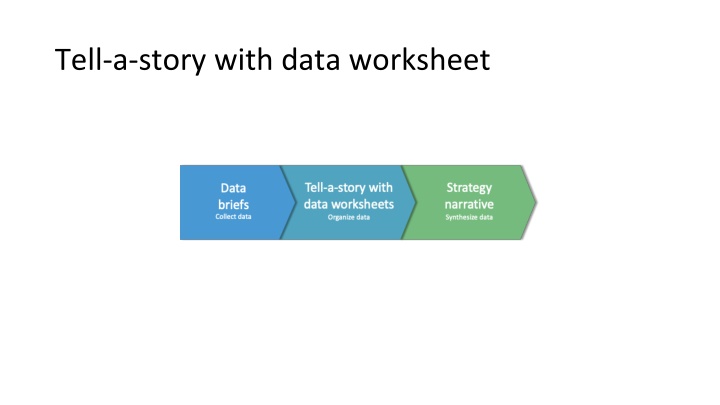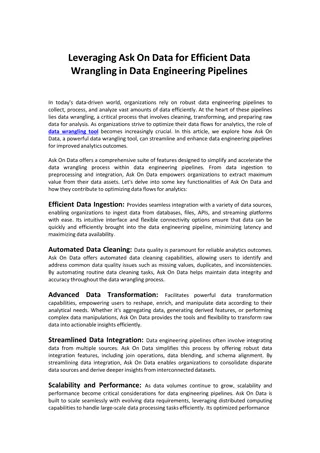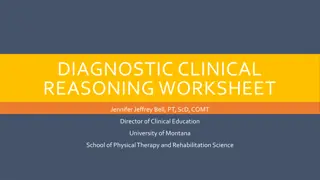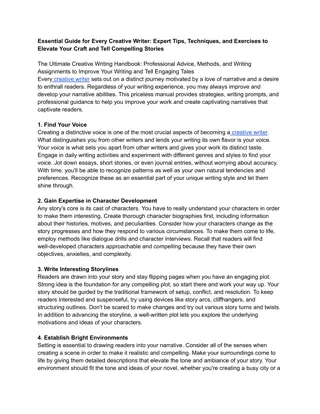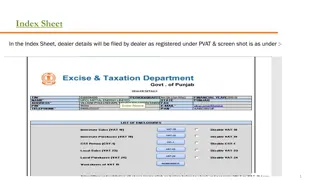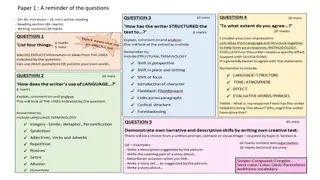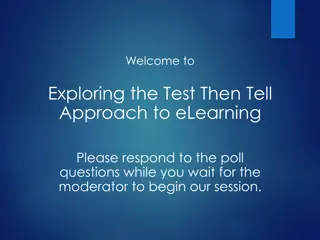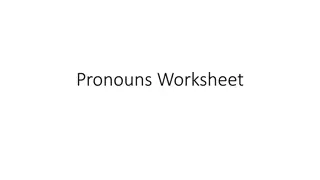Tell-a-story with data worksheet
Dive into the world of Malaria Case Management with detailed data briefs and analyses to craft effective intervention-specific communication plans. Explore behavioral insights and drivers behind community behaviors to enhance situation analysis and strategy development for combating Malaria effectively.
Download Presentation

Please find below an Image/Link to download the presentation.
The content on the website is provided AS IS for your information and personal use only. It may not be sold, licensed, or shared on other websites without obtaining consent from the author.If you encounter any issues during the download, it is possible that the publisher has removed the file from their server.
You are allowed to download the files provided on this website for personal or commercial use, subject to the condition that they are used lawfully. All files are the property of their respective owners.
The content on the website is provided AS IS for your information and personal use only. It may not be sold, licensed, or shared on other websites without obtaining consent from the author.
E N D
Presentation Transcript
Intervention-specific communication plans Intervention: use the Malaria Case Management data brief to fill boxes on each of the following slides (adding boxes and data as available). This will help build and complete the situation analysis and behavioral analysis sections of the strategy. Knowledge % who know Access % with access Exposure % who heard or saw messages Attitudes Efficacy, risk, norms Behavior % who practice behavior Health Morbidity and mortality
Malaria case management Attitudes, Efficacy, Norms Exposure Community Behaviors % who ever heard messages or information about .. Knowledge Access % of caregivers who .. % who have correct knowledge about .. % of all household members who .. % who have access to .. Situation analysis and behavioral analysis: While access, exposure, knowledge, attitudes, efficacy, and norms will be described in the behavioral analysis, actual behaviors will be described in the situation analysis (use data from the malaria case management data brief to complete the following slides)
Situation analysis Malaria SBC strategies should include a situation analysis for each intervention. These situation analyses should include quantitative and qualitative data that describes who is affected and how severely (to what extent) by which problems.
? ? ? ? Behavior % who practice behavior ? ? Situation analysis: use the malaria case management data brief (behaviors section) to fill in these boxes (add boxes as necessary). A narrative summary will be used to complete the strategy malaria case management situation analysis.
Summarize your data here in narrative form and paste it into the strategy template malaria case management situation analysis section Situation analysis:
Behavior analysis The description of the underlying drivers behind specific behaviors is articulated in a behavioral analysis. This analysis summarizes any data explaining why certain audiences or target groups choose to practice, or refuse to practice, healthy behaviors. As determinants of behavior may be structural, cognitive, social, or emotional, it is important to collect data to better understand what drives specific audiences to behave as they do. Each behavioural analysis should describe these determinants in context.
? ? ? ? Access ? ? Behavior analysis: use the malaria case management data brief to fill in these boxes (add boxes as necessary). A narrative summary of behavioral determinants will be used to complete the strategy malaria case management behavior analysis.
? ? % who saw or heard message in the last 6 months % exposed to each channel of communication Exposure ? ?
? ? ? ? Knowledge ? ?
? ? Positive attitudes ? ? ? ?
? ? ? ? Response efficacy ? ?
? ? ? ? Self efficacy ? ?
? ? Social norms ? ? ? ?
? ? ? ? Decision making ? ?
? ? ? ? ? ? ? ? ? Exposure % who heard or saw messages Access % with access to facility or CHW ? ? ? ? ? Situation analysis: use the malaria case management data brief to fill in these boxes (add boxes as necessary). A narrative summary of data collected will be used to complete the strategy malaria case management situation analysis.
? ? ? ? ? ? ? Social Norms Knowledge % who have correct knowledge Attitudes Efficacy ? ? ? ? ? Behavior analysis: use the malaria case management data brief to fill in these boxes (add boxes as necessary). A narrative summary of behavioral determinants will be used to complete the strategy malaria case management behavior analysis.
Example: Cte dIvoire Family & Friends 6.3% cited friends and relatives as source of malaria messages Radio 21.7% Gender Roles & Decision-Making Household roles and economic power to make healthcare decisions Supplies Facilities have medicine to treat malaria cited radio as source of malaria messages Print 5.9% Training 81.7% agree that CHWs know how to treat malaria TV 65.8% cited TV as source of malaria messages cited billboards and posters as source of malaria messages Exposure % who heard or saw messages Access % with access to facility or CHW Standards of Care 58.3% of children with fever taken to a health facility received a diagnostic test Finances 73.6% are charged for malaria treatment medications for children Health Worker 4.6% cited health workers as source of malaria messages
Example: Cte dIvoire Attitude 93.5% women and 93.4% men had a positive attitude toward malaria treatment Testing 87.6% believe blood test is necessary to confirm malaria Self-Efficacy 94.7% are confident they can take their child to a health facility at the first sign of malaria Symptoms 79.7% cite fever as a symptom of malaria Norms 73.2% Treatment 39.5% know ACTs are effective treatment for malaria believe most people in their community take their children to a health provider the same or next day a fever develops Knowledge % who have correct knowledge Attitudes Efficacy Social Norms Testing Care 96.3% Timing 92.0% respondents who know that malaria can be detected in the blood through a malaria test Efficacy 58.4% believe diagnostic tests are effective believe a health worker is always the best person to talk to about suspected malaria believe child should be taken to health facility the same day fever begins
Summarize your data here in narrative form and paste it into the strategy template case management behavior analysis section Example: C te d Ivoire Attitude 93.5% women and 93.4% men had a positive attitude toward malaria treatment Testing 87.6% believe blood test is necessary to confirm malaria Self-Efficacy 94.7% are confident they can take their child to a health facility at the first sign of malaria Behavior analysis: Norms 73.2% Treatment 39.5% know ACTs are effective treatment for malaria believe most people in their community take their children to a health provider the same or next day a fever develops Knowledge % who have correct knowledge Attitudes Efficacy Social Norms Care 96.3% Timing 92.0% believe child should be taken to health facility the same day fever begins Efficacy 58.4% believe diagnostic tests are effective believe a health worker is always the best person to talk to about suspected malaria
Audience analysis and strategic approaches An audience analysis should describe primary, secondary, and tertiary audience characteristics as they relate to each behaviour. Both socio-demographic (sex, age, language, etc.) and psycho-social characteristics (personality, attitudes, beliefs, values, emotions, etc.) should be described, as well as any available data on media consumption habits, message exposure, and message recall among specific sub-groups Strategic approaches should describe how to best reach and influence each audience. Following the socio-ecological model, use the audience analysis to specify how to reach and influence each audience at the structural, social, and individual level.
Audience analysis and strategic approaches Case management audience analysis Audience analysis: Primary audience: Secondary audiences: Tertiary audiences: Strategic communication approaches: Primary audience: Secondary audiences: Tertiary audiences: (Where appropriate) Considerations for low, very low, and zero transmission:
Behavior-specific communication plans Each intervention-specific plan should contain behavior-specific plans, which address specific behavioural objectives. A behavioural objective articulates what behavior must change. Behavioural objectives measure a single behavior and specify the audience whose behavior is expected to change.
Case management behavior no.1 [list here] Behavior objective [list here] Primary audience: Secondary audience:: Communication objective n 1 : Communication objective n 2 : Key benefit: Supporting points:
Case management behavior no.2 [list here] Behavior objective [list here] Primary audience: Secondary audience: Communication objective n 1 : Communication objective n 2 : Key benefit: Supporting points:
Case management behavior no.3 [list here] Behavior objective [list here] Primary audience: Secondary audience:: Communication objective n 1 : Communication objective n 2 : Key benefit: Supporting points:
